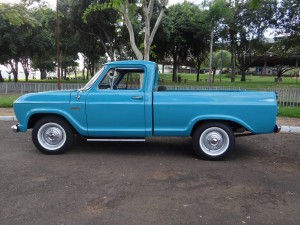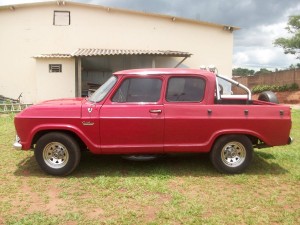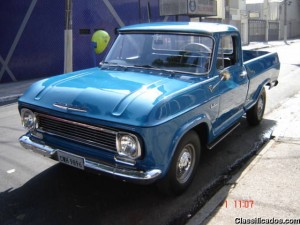Send an answer to a topic: General Motors do Brasil trucks
Warning, this subject is old (3615 days without answer)
eLMeR
1st question: with all these names for the pickups (Chevrolet C-14 / C-15 / C/D/A-10 / Chevy 4 / C/D-1000) throughout all these years, how should we call them?
As said above, GM do Brasil used Série C-10 from 1973 to 1979, so should we do it that way, even for D-10 and A-10, or could the Série 10 name used for the 1985+ models be the solution?
2nd question, due to the 2nd note about the picapes: even if the face-lift took place in late 1979, do we keep 1979 as default model year for the "plastic grille" models? This way, it would fit the brochures (see the links in the note concerned), which are assumed to give the accurate MY...
As said above, GM do Brasil used Série C-10 from 1973 to 1979, so should we do it that way, even for D-10 and A-10, or could the Série 10 name used for the 1985+ models be the solution?
2nd question, due to the 2nd note about the picapes: even if the face-lift took place in late 1979, do we keep 1979 as default model year for the "plastic grille" models? This way, it would fit the brochures (see the links in the note concerned), which are assumed to give the accurate MY...
eLMeR
My sources: LexiCar Brasil (pt), Caminhões Antigos Brasileiros (pt), the Portuguese/Brazilian Wikipedia (pt), Portal São Francisco (pt - this one not very reliable: it's only a digest of other sites of varying quality), Mercado Livre (pt - classified ads site) and some brochures. Pictures are from these sites.
Feel free to correct and/or to complete these informations.
___________
I) 1964-84 Chevrolet C-14 / C-15 / C/D/A-10 / Chevy 4 / C/D-1000
(Gallery)
March 1964:
Unveiling of the C-14 picape (pickup, in Brazilian) and its derivatives: long model C-15, chassis + cab, double cab pickup1. It was designed by the Departamento de Estilo (Styling Department) of General Motors do Brasil, made on a local engineered chassis but with the instrument cluster from the 1960-66 US Chevrolet C/K series.
The truck is powered by a 261 ci / 4,300 cm³ gasoline engine (151 hp SAE) called Chevrolet Brasil and made in Brazil since 1958. The gearbox is a 3-speed model.
November 1966:
New grille, with only 2 headlamps.
1971? (year to be confirmed):
4WD (Tração Total) versions are now available.
1973:
C-14 and C-15 are merged as Série C-10, but keep their 14xx and 15xx internal codes.
The visible difference between the C-14 / C-15 and the new C-10 seems to be the vertical emblem on the fender. But it's just a guess due to the observation of several picture, I don't know if it's a fully reliable clue.
June 1976:
Due to the oil crisis, launch of the Chevy 4, a C-10 with the 4-cylinder engine of the Opala (2.5L / 87 hp). There is no real difference visible from the outside, except from smaller wheels and a 3-bar grille similar to the one of the heavy-duty trucks.
(I found only one source -LexiCar Brasil- talking about this truck. But it is fairly reliable, in my opinion. Just a single picture too, from the same source)
1978:
The "team" is reinforced with the new D-10 and its 4-cylindre Diesel engine (Perkins / 3.9L / 77 hp).
2nd semester of 19792:
• New grille for the C-10 / D-10 family, made of black plastic, accompanied by a steep angle hood front.
• A 1979-81 C/D-1000 model with a 1,000 kg/2,205 lb payload (to be compared to the 750 kg/1,653 lb of the standard C-10) is added to the range of trucks. It had apparently no external difference with the standard model.
1980:
The pickup line gains an alcohol powered engine with the A-10 model (4-cylindre / 2.5L / 89 hp at first, plus a 6-cylindre / 4.1L / 122 hp in 1981). All picapes and their derivatives have now front disk brakes.
From then on, no other external change until 1985 and the new truck line.
From 1980 to 1984, the sales proportions for the engines were apparently 70% for the Diesel option, 26% for the alcohol one and 4% for the gasoline one.
In the next episodes: 1964-89 Veraneio, 1964-84 C-60 to D-80, 1985+ models... Stay tuned!
The different bodies:
____________
(1) About "chassis" code: GM do Brasil use the same codes as Chevrolet "of USA". Which means:
• 1403 / 1503 for chassis + cab;
• 1404 / 1504 for pickups;
• 1412 / 1512 for cowl + chassis + windshield;
• 1416 for the Brazilian Suburban equivalent (1964-69 C-1416 / 1969+ Veraneio)
And one is added:
• 1414 for pickups with a double cab. All these Cabine dupla models were apparently made on the short wheelbase of the C-14, whatever the MY is. I think this one (a 1979+ model, due to the hood), obviously made on a long wheelbase, is a "custom made".
____
(2) The years given in Brazilian sites seem to refer to "2nd semester of...", so it would be interesting to know how the model years are identified in Brazil: in "IMCDb habits", this (2nd semester) 1979 change should be understand as a 1980 one, but the related brochures say 1979 (see C-10, D-60)...
Feel free to correct and/or to complete these informations.
___________
I) 1964-84 Chevrolet C-14 / C-15 / C/D/A-10 / Chevy 4 / C/D-1000
(Gallery)
March 1964:
Unveiling of the C-14 picape (pickup, in Brazilian) and its derivatives: long model C-15, chassis + cab, double cab pickup1. It was designed by the Departamento de Estilo (Styling Department) of General Motors do Brasil, made on a local engineered chassis but with the instrument cluster from the 1960-66 US Chevrolet C/K series.
The truck is powered by a 261 ci / 4,300 cm³ gasoline engine (151 hp SAE) called Chevrolet Brasil and made in Brazil since 1958. The gearbox is a 3-speed model.
November 1966:
New grille, with only 2 headlamps.
1971? (year to be confirmed):
4WD (Tração Total) versions are now available.
1973:
C-14 and C-15 are merged as Série C-10, but keep their 14xx and 15xx internal codes.
The visible difference between the C-14 / C-15 and the new C-10 seems to be the vertical emblem on the fender. But it's just a guess due to the observation of several picture, I don't know if it's a fully reliable clue.
June 1976:
Due to the oil crisis, launch of the Chevy 4, a C-10 with the 4-cylinder engine of the Opala (2.5L / 87 hp). There is no real difference visible from the outside, except from smaller wheels and a 3-bar grille similar to the one of the heavy-duty trucks.
(I found only one source -LexiCar Brasil- talking about this truck. But it is fairly reliable, in my opinion. Just a single picture too, from the same source)
1978:
The "team" is reinforced with the new D-10 and its 4-cylindre Diesel engine (Perkins / 3.9L / 77 hp).
2nd semester of 19792:
• New grille for the C-10 / D-10 family, made of black plastic, accompanied by a steep angle hood front.
• A 1979-81 C/D-1000 model with a 1,000 kg/2,205 lb payload (to be compared to the 750 kg/1,653 lb of the standard C-10) is added to the range of trucks. It had apparently no external difference with the standard model.
1980:
The pickup line gains an alcohol powered engine with the A-10 model (4-cylindre / 2.5L / 89 hp at first, plus a 6-cylindre / 4.1L / 122 hp in 1981). All picapes and their derivatives have now front disk brakes.
From then on, no other external change until 1985 and the new truck line.
From 1980 to 1984, the sales proportions for the engines were apparently 70% for the Diesel option, 26% for the alcohol one and 4% for the gasoline one.
In the next episodes: 1964-89 Veraneio, 1964-84 C-60 to D-80, 1985+ models... Stay tuned!

1964-66 C-14 | 1967-72 C-14 |
1973-79 C-10 | 1979-84 C-10 |
The different bodies:

| 
|
Short wheelbase (2.92 m/ 115") C-1404 | Long wheelbase (3.23 m/ 127.125") C-1504 |

| 
|
Picape Cabine dupla (C-1414) | 1976-? Chevy 4 |
____________
(1) About "chassis" code: GM do Brasil use the same codes as Chevrolet "of USA". Which means:
• 1403 / 1503 for chassis + cab;
• 1404 / 1504 for pickups;
• 1412 / 1512 for cowl + chassis + windshield;
• 1416 for the Brazilian Suburban equivalent (1964-69 C-1416 / 1969+ Veraneio)
And one is added:
• 1414 for pickups with a double cab. All these Cabine dupla models were apparently made on the short wheelbase of the C-14, whatever the MY is. I think this one (a 1979+ model, due to the hood), obviously made on a long wheelbase, is a "custom made".
____
(2) The years given in Brazilian sites seem to refer to "2nd semester of...", so it would be interesting to know how the model years are identified in Brazil: in "IMCDb habits", this (2nd semester) 1979 change should be understand as a 1980 one, but the related brochures say 1979 (see C-10, D-60)...



